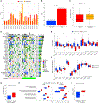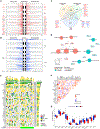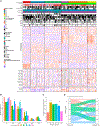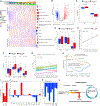Proteogenomic characterization of primary colorectal cancer and metastatic progression identifies proteome-based subtypes and signatures
- PMID: 38377004
- PMCID: PMC11288375
- DOI: 10.1016/j.celrep.2024.113810
Proteogenomic characterization of primary colorectal cancer and metastatic progression identifies proteome-based subtypes and signatures
Abstract
Metastatic progression of colorectal adenocarcinoma (CRC) remains poorly understood and poses significant challenges for treatment. To overcome these challenges, we performed multiomics analyses of primary CRC and liver metastases. Genomic alterations, such as structural variants or copy number alterations, were enriched in oncogenes and tumor suppressor genes and increased in metastases. Unsupervised mass spectrometry-based proteomics of 135 primary and 123 metastatic CRCs uncovered distinct proteomic subtypes, three each for primary and metastatic CRCs, respectively. Integrated analyses revealed that hypoxia, stemness, and immune signatures characterize these 6 subtypes. Hypoxic CRC harbors high epithelial-to-mesenchymal transition features and metabolic adaptation. CRC with a stemness signature shows high oncogenic pathway activation and alternative telomere lengthening (ALT) phenotype, especially in metastatic lesions. Tumor microenvironment analysis shows immune evasion via modulation of major histocompatibility complex (MHC) class I/II and antigen processing pathways. This study characterizes both primary and metastatic CRCs and provides a large proteogenomics dataset of metastatic progression.
Keywords: CP: Cancer; biomarkers; colorectal cancer; hypoxia; mass spectrometry; metastasis; molecular signature; proteomics; stemness; subtyping; tumor immune microenvironment.
Copyright © 2024. Published by Elsevier Inc.
Conflict of interest statement
Declaration of interests D.S.K. was a consultant for and is now employed by Paige.AI. P.G.B. and J.G. are employees of and hold equity interests in Genuity Science. J.Y.W. is the founder of Curandis. M.H.A.R. is a member of the scientific advisory boards of Azenta Life Sciences and Universal DX. None of these companies had any role in design, execution, data analysis, or any other aspect of this study.
Figures







References
-
- Mendelaar PAJ, Smid M, van Riet J, Angus L, Labots M, Steeghs N, Hendriks MP, Cirkel GA, van Rooijen JM, Ten Tije AJ, et al. (2021). Whole genome sequencing of metastatic colorectal cancer reveals prior treatment effects and specific metastasis features. Nat. Commun 12, 574. 10.1038/s41467-020-20887-6. - DOI - PMC - PubMed
Publication types
MeSH terms
Substances
Grants and funding
LinkOut - more resources
Full Text Sources
Medical
Research Materials
Miscellaneous

